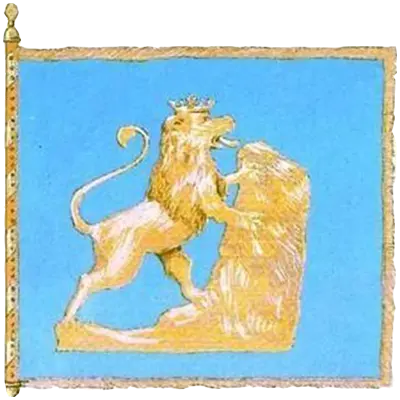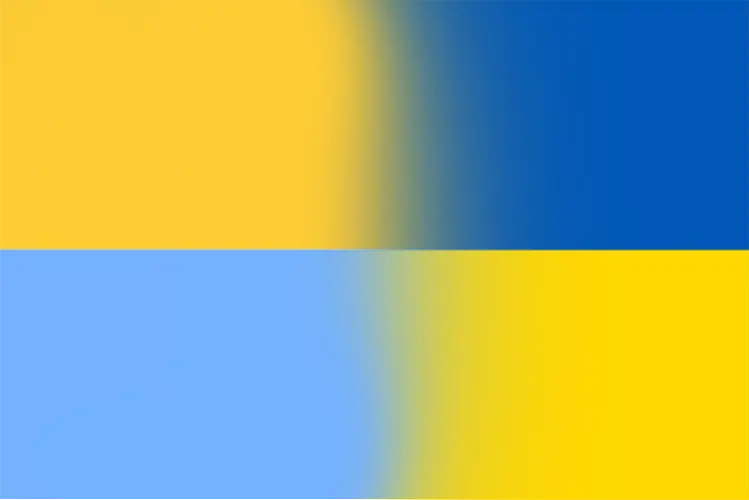
The combination of blue and yellow on the Ukrainian flag has historical significance and has been used since the Middle Ages. Lviv, founded in 1256, had a coat of arms with a yellow lion on a blue background. In the 14th century, gold and blue were officially used in the coat of arms of the Rus' Kingdom and were also found in the coats of arms of local nobility. The Cossacks of the Zaporozhian Sich also frequently used blue and yellow in their flags starting in the 18th century. During the "Spring of Nations" of 1848, the Main Russian Council in Lviv restored the coat of arms of the Russian Kingdom of the 13th and 14th centuries, and blue and yellow banners were widely used as national flags. On May 5, 1900, the Ukrainian sports association Sich began operating under the blue and yellow flag in Galicia, and with mass emigration in the late 19th century, the concept of the blue and yellow flag spread to the Transcarpathian lands and Ukrainian settlements in America.
In 1917, Ukrainian blue and yellow flags appeared in public for the first time since the February Revolution. This happened in Kyiv, Odesa, and Kharkiv. Under these flags, units of the Tsarist army and the Black Sea Fleet were Ukrainized during World War I. On March 17, 1917, the organization of the Central Rada was proclaimed, and Ukrainian blue and yellow flags began to appear publicly in Kyiv. Mykhailo Hrushevsky, the first president of Ukraine, officially adopted this color combination as the country's flag. Under the blue and yellow flag, Ukrainian youth fought against the Russian Bolsheviks and the Ukrainian Galician Army during the Ukrainian-Polish War and on the anti-Bolshevik front. The flag of the West Ukrainian People's Republic also had the same blue and yellow colors.
There are still discussions about the arrangement of colors on the Ukrainian flag. Some argue that the current arrangement of blue on top is correct, while others believe that yellow should be on top, as it was during the Ukrainian People's Republic. Modern researchers have not found any documents that would approve the "yellow-blue" color order in the Ukrainian People's Republic. Documents of the time show the use of both variants, as do old photographs.

In the early 1940s, the revolutionary faction of the Organization of Ukrainian Nationalists (OUNR) sought to create its own red and black symbols to distinguish itself from the OUN, which used a blue flag and a golden coat of arms with a trident and sword. The red and black flag gained popularity among young people, but remained unofficial until the outbreak of the Soviet-German war. Many fighters of the armed wing of the OUN, the UPA, did not know these colors and fought under blue and yellow flags. From March to May 1939, Carpathian Ukraine fought for its independence under the blue and yellow flag.
During the Soviet era, the blue and yellow flag of Ukraine was banned, and displaying the flag was considered a crime with severe consequences. However, there were cases when people risked punishment to show their support for Ukraine. In 1966, two people climbed a building in Kyiv and replaced a Soviet flag with a Ukrainian one. They were later convicted and fought for freedom even after Ukraine gained independence. In 1967, an unknown person hung a blue and yellow flag in the Dnipro River with a trident and an inscription in honor of Ukraine's independence. In 1976, a student in Toronto waved a Ukrainian flag during an Olympic handball match and was ejected from the arena. During a soccer match the same year, a young man ran onto the field with a blue and yellow flag and danced hopak, while fans raised placards reading "Freedom to Ukraine!" In 1989, the activist raised the national flag in Lviv during a rally in memory of the Chernobyl disaster. This flag had a golden trident embroidered on it. These cases demonstrate the determination of people to challenge the Soviet regime and express their support for Ukraine.
In 1991, the Ukrainian national flag was introduced to the Verkhovna Rada, despite opposition from the pro-communist majority. The flag was officially approved as a national symbol in 1992, and the National Flag Day of Ukraine was established in 2004 and is celebrated on August 23. In 1990, the blue and yellow flag was raised over the Kyiv City Council. The winter of 2013-2014 was a turning point for the perception of state symbols in Ukraine, as the Maidan protests, the deaths of the Heavenly Hundred Heroes, and ongoing tragedies affected attitudes toward the symbols. In 2014, a member of the city council was kidnapped and killed in Horlivka as he tried to replace a separatist flag with a Ukrainian one.
Throughout the defense of the Donetsk airport, the Ukrainian flag was constantly raised by fighters who were nicknamed "cyborgs." Despite the enemy's attempts to bring the flags down, the symbol of the Ukrainian state was raised again and again. Unfortunately, over time, the enemy destroyed the control tower where the flag was flying. There were also other cases of patriotism, such as when local residents of Sudak in the occupied Crimea raised the Ukrainian flag in honor of fallen soldiers and captured sailors. Although the war against the Russian Federation, which invaded Ukraine, began in 2014, outbreaks of patriotism, self-identification as Ukrainians, communication in the state language, and love for state symbols occurred in 2022 after Russia's full-scale invasion of Ukraine. The blue and yellow flag has become a powerful symbol for Ukraine, which is fighting for its freedom and future.
In July 2022, after the Ukrainian Armed Forces cleared the area, a blue and yellow flag with the caption "Remember the 'Russian warship' Zmeinyi Island is Ukraine!!!" was raised on Zmeinyi Island. In a liberated village in the Kharkiv region, cans with the flag of Ukraine were dug up in the garden; a local buried the flag during the occupation to prevent it from being taken by the Russians. In the lyceum of the village of Tsyrkuny, a flag signed by ATO participants - defenders who left the Ilovaisk cauldron - was preserved. The wall with the state symbols, painted by the lyceum's art teacher, was shot at, but the historic flag was preserved. Children in basements, bomb shelters, during the occupation, painted the blue and yellow flag on the walls and greeted the Ukrainian soldiers on the liberated territories with it.






